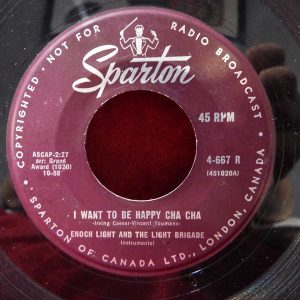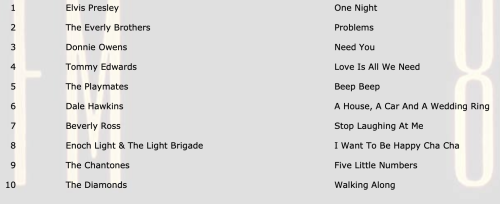#27: I Want To Be Happy Cha Cha by Enoch Light and the Light Brigade
City: London, ON
Radio Station: CKSL
Peak Month: November 1958
Peak Position in London ~ #8
Peak position in Vancouver ~ #30
Peak Position on Billboard Hot 100 ~ #48
YouTube: “I Want To Be Happy Cha Cha”
Enoch Light was born in Canton, Ohio, in 1907. He was a leader of various dance bands, forming his first at Johns Hopkins University while he was a student. Light’s first dance band recorded as early as March 1927 and continuing through at least 1940. Light and his band primarily worked in various hotels in New York. For a time in 1928, Enoch Light also led a band in Paris, France. He also studied classical conducting at the Opéra-Comique (founded in 1714). In the 1930s, Light also studied conducting with the French conductor Maurice Frigara in Paris. Throughout the 1930s, Light and his outfits were steadily employed in the generally more upscale hotel restaurants and ballrooms in New York that catered to providing polite ambiance for dining and functional dance music of current popular songs rather than out-and-out jazz.
At some point his band was tagged The Light Brigade and they often broadcast over radio live from the Hotel Taft in New York, where they had a long residency. Through 1940, Light and his band recorded for various labels including Brunswick, ARC, Vocalion and Bluebird. In 1955, Light founded Grand Award Records and served as president and A&R chief.
During the ’50s, Enoch Light covered numbers of popular songs. This includes “Shrimp Boats”, “Mr. Sandman”, “Detour”, “Cry”, “Rags To Riches”, “Eh, Cumpari”, and “Unchained Melody”. In 1958, he recorded “I Want To Be Happy Cha Cha”.

“I Want To Be Happy Cha Cha” was composed by Irving Caesar (born Isidor Keiser in 1895 in New York City) and Vincent Youmans (born 1898 in New York City). Caesar was the son of a Romanian Jew. He was acquainted with the Marx Brothers in his childhood. In 1920, he cowrote with George Gershwin “Swanee”, a number-one hit for Al Jolson. In 1922, he cowrote with Eddie Cantor “I Love Her – She Loves Me”, which was a #3 hit for Cantor. In 1924, he cowrote “I Want To Be Happy” with Vincent Youmans, which became a #2 hit for Vincent Lopez and His Orchestra, as well as a #5 hit for Carl Fenton and His Orchestra. In 1925, Youmans and Caesar cowrote “Tea For Two”, which peaked at #1 for Marion Harris. It was also a Top Ten hit that year for The Benson Orchestra of Chicago, and Ben Bernie & His Orchestra. Decades later, the tune would become a #7 hit for Tommy Dorsey in 1958.
In 1927, Youmans and Caesar wrote “Sometimes I’m Happy”, a #5 hit for Roger Wolfe Kahn & His Orchestra. Other Top Ten hits in the late ’20s that Irving Caesar penned include “Crazy Rhythm” for Roger Wolfe Kahn, “You’re A Real Sweetheart” for Nick Lucas, and “My Blackbirds Are Bluebirds Now” for Ruth Etting.
In the 1930s, Irving Caesar penned more Top Ten hits, including for Ted Lewis & His Band “(Just A Gigilo” – #1 in 1931). The song was recorded by the Village People in 1978. Caesar wrote more songs for Nick Lucas (“Lady Play Your Mandolin” – #5 in 1931), Wayne King and His Orchestra (“Sweethearts Forever” – #3 in 1932), Eddie Cantor (“What A Perfect Combination” – #7 in 1932), Rudy Vallée & His Connecticut Yankees (“Nasty Man” – #10 in 1934), and Jimmy Dorsey and His Orchestra (“Is It True What They Say About Dixie” – #1 in 1936), among others. In 1972, he was inducted into the Songwriters Hall of Fame. Irving Caesar died in 1996 at age 101.
Vincent Youmans wrote a number-one hit in 1923 for Paul Whiteman titled “Bambalina”. Other notable hits Youmans penned in the 1920s include “Wildflower”, a #3 hit for Ben Bernie and His Orchestra (1923), “Deep In My Heart” – #5 for Benny Kruger and His Orchestra (1924), “Hallelujah!” – #3 and “I Know That You Know” – #5 and both for Nat Shilkret & the Victor Orchestra in 1927. In 1929, Youmans penned “Great Day”, which was a #1 hit for Paul Whiteman. Also in 1929, he cowrote “More Than You Know” for Ruth Etting which peaked at #9.
In the 1930s, Vincent Youmans had hit songs with “Without A Song” for Paul Whiteman (#6 in 1930), “Time On My Hands” which was separately a #6 hit first for Leo Reisman and next for Smith Ballew. Youmans had a number-one hit with “The Carioca” for Enric Madriguera and His Orchestra (1934). While “Flying Down to Rio” was a #6 hit for both Rudy Vallée, and for Fred Astaire. Again in 1934, Rudy Vallée had the biggest his with Youmans’ “Orchids in the Moonlight”.
Over the years Vincent Youmans wrote scores for fourteen Broadway musicals. He also wrote music for nine films. Youmans died in 1946 at the age of 47 of tuberculosis.
“I Want To Be Happy” was originally written by Caesar and Youmans in 1924 for the Broadway musical No, No Nanette.
The farcical story centers on three couples who find themselves together at a cottage in Atlantic City, New Jersey. This occurs in the midst of a blackmail scheme focusing on a fun-loving Manhattan heiress who has run off, leaving an unhappy fiancé. In Act 1, Nanette (an underage heiress to her father’s fortune) wants to go to Atlantic City with her friends, but her mother Sue forbids her to go. Nanette’s father and millionaire Bible pusher – Jimmy Smith – wants to make Nanette happy. He gives her $200 (about $3,700 in 2025 dollars) and agrees to secretly take her to Chickadee Cottage. Jimmy assigns his grumpy cook, Pauline, to act as Nanette’s chaperone. Cue the song: “I Want to Be Happy”, sung by Jimmy, Nanette and a chorus.
Enoch Light’s “I Want To Be Happy Cha Cha” is an instrumental treatment of the 1924 hit song. It was arranged to a cha-cha beat. The creation of cha-cha-chá is attributed to Cuban composer and violinist Enrique Jorrín who began his career playing for the charanga band Orquesta América. Since its inception, cha-cha-chá music has had a close relationship with the dancer’s steps. The name cha-cha-chá came into being with the help of the dancers at the Silver Star Club in Havana. When the dance was coupled to the rhythm of the music, it became evident that the dancer’s feet were making a peculiar sound as they grazed the floor on three successive beats.
Other singles in the late ’50s mentioned the cha-cha-cha. Tommy Dorsey’s “Tea For Two Cha Cha” was a #2 hit in the summer of 1958. Sam Cooke’s “Everybody Loves to Cha Cha Cha” was a Top 40 hit in 1959. The DeCastro Sisters released “Teach Me Tonight Cha Cha”, while Sy Oliver and His Orchestra released “In A Little Spanish Town Cha Cha”.
“I Want To Be Happy Cha Cha” peaked at #2 in Caribou (ME), #3 in Toledo (OH), #4 in Albany (NY), #5 in Bethesda (MD), #7 in Baltimore (MD), #8 in London (ON), and Sioux Falls (SD), #9 in Akron (OH), and #10 in Long Beach (CA).
Enoch Light pioneered many recording techniques such as the use of 35mm magnetic film instead of magnetic tape, reducing wow and flutter, being driven by sprockets rather than a rubber pinch wheel.
Light released 25 albums over 12 years (1959–71), with two of them reaching number one on the U.S. Billboard album chart. He holds the record for having the most charting LPs without having a Top 40 single, as reported by Casey Kasem on the American Top 40 broadcast of October 14, 1978. Enoch Light died in July 1978 at the age of 70, 19 days before his 71st birthday.
March 5, 2025
Ray McGinnis
References:
John S. Wilson, “Enoch Light, Leader of a Big Band, Stereo Recording Innovator, Dead,” New York Times, August 1, 1978.
Richard Severo, “Irving Caesar, Lyricist of Timeless Hits Like ‘Tea for Two,’ Dies at 101,” New York Times, December 18, 1996.
“Vincent Youmans,” Wikipedia.org.
“No No Nanette,” Wikipedia.org.

CKSL1410-AM London (ON) Top Ten | November 29, 1958

Leave a Reply